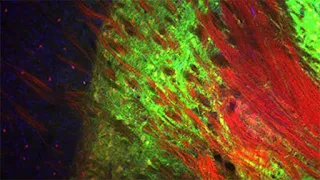Descobertos Alvos Neuronais que restauram o movimento em modelos animais com Doença de Parkinson
"Researchers working in the lab of Carnegie Mellon University
neuroscientist Aryn Gittis have identified two groups of neurons that
can be turned on and off to alleviate the movement-related symptoms of
Parkinson’s disease. The activation of these cells in the basal ganglia
relieves symptoms much longer than current therapies, like deep brain
stimulation and pharmaceuticals.
The study,
completed in a mouse model of Parkinson’s, used optogenetics to better
understand the neural circuitry involved in Parkinson’s disease, and
could provide the basis for new experimental treatment protocols (...).
Parkinson’s disease is caused when the dopamine neurons that feed into
the brain’s basal ganglia die and cause the basal ganglia to stop
working, preventing the body from initiating voluntary movement.
The basal ganglia is the main clinical target for treating Parkinson’s
disease, but currently used therapies do not offer long-term solutions.
“A major limitation of Parkinson’s disease treatments is that they
provide transient relief of symptoms. Symptoms can return rapidly if a
drug dose is missed or if deep brain stimulation is discontinued,” said
Gittis, assistant professor of biological sciences in the Mellon College
of Science and member of Carnegie Mellon’s BrainHub neuroscience
initiative and the CNBC. “There is no existing therapeutic strategy for
long lasting relief of movement disorders associated with Parkinson’s.
To better understand how the neurons in the basal ganglia behave in
Parkinson’s, Gittis and colleagues looked at the inner circuitry of the
basal ganglia. They chose to study one of the structures that makes up
that region of the brain, a nucleus called the external globus pallidus
(GPe). The GPe is known to contribute to suppressing motor pathways in
the basal ganglia, but little is known about the individual types of
neurons present in the GPe, their role in Parkinson’s disease or their
therapeutic potential.
The research group used optogenetics, a
technique that turns genetically tagged cells on and off with light.
They targeted two cell types in a mouse model for Parkinson’s disease:
PV-GPe neurons and Lhx6-GPe neurons. They found that by elevating the
activity of PV-GPe neurons over the activity of the Lhx6-GPe neurons,
they were able to stop aberrant neuronal behavior in the basal ganglia
and restore movement in the mouse model for at least four hours —
significantly longer than current treatments.
While optogenetics
is used only in animal models, Gittis said she believes their findings
could create a new, more effective deep brain stimulation protocol.”
Comentário de Catarina Almeida: A
doença de Parkinson é uma doença neurodegenerativa que afeta 1 em cada
500 pessoas e a sua incidência aumenta com a idade. Nesta doença há
degeneração progressiva dos neurónios dopaminérgicos na substância
nigra, levando à diminuição da dopamina no estriado.
Esta perda da transmissão dopaminérgica causa os sintomas desta doença:
tremor, rigidez e bradicinesia, e por isso, as pessoas são incapazes de
controlar os seus movimentos. Até hoje, ainda não existe uma cura e os
tratamentos existentes perdem o seu efeito a longo prazo. E é aqui que
este estudo faz a diferença. Os investigadores da Universidade Carnegie
Mellon descobriram, através da optogenética, dois grupos de neurónios
que podem ser ativados e desativados para aliviar os sintomas da doença
de Parkinson, de forma mais eficiente que as terapias atuais. Apesar de
ter sido feito em ratinhos, este estudo permitiu entender melhor os
circuitos neurais envolvidos nesta doença e assim, pode fornecer a base
para novos protocolos de tratamento experimental.


Comentários
Enviar um comentário